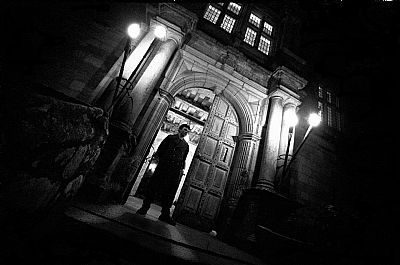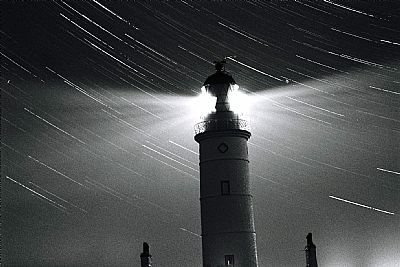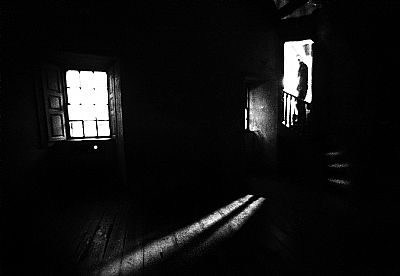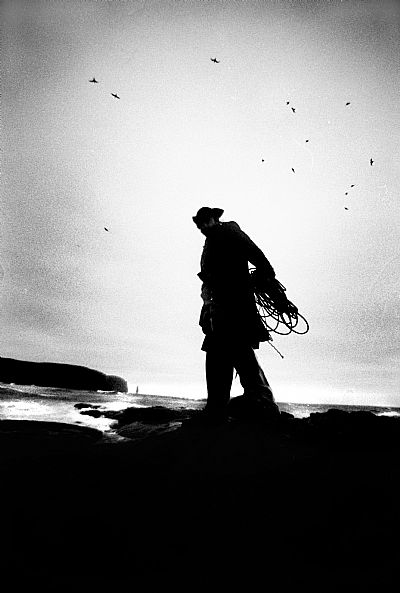Excerpts
Chillingham Castle, The Radiant Blue Boy And The Grey Lady

"...On my first ever stay at the castle, I stalled the engine driving through the archway to the private parking at the rear of the dairy, only to be informed much later on by the caretaker (quite without prompting) that ‘you would not believe how many people stall driving through that arch!’ I also awoke in the middle of the night (having had little to drink) to hear two young women’s voices in conversation in a language alien to me. And with the ghost tour at night by the hanging tree, I stepped back to avoid colliding with a dark shadow passing quickly in front of me, only to look up and find I was isolated a good thirty feet away from the rest of the group. I have also recorded strange flashes and orbs on 35 mm film which defy easy explanation. Latterly, I missed out on flashing white lights in the Grey apartment bedroom, which were witnessed by my sister and Lady ‘T’ (holy water was banned this time). They also heard, as did others who were staying at the time, the sounds of music and footsteps deep in the night outside their door. Unfortunately with the apartment full, on this occasion I volunteered to stay in an external apartment alone. This meant I had a lonely and very disconcerting journey back in the early hours of the morning. First I had to negotiate my way down a cold stone tower spiral staircase, then cross the echoing, deep shadowed courtyard with its four high curtain walls and leering black windows. Then on to the opposite end of the castle near the torture chambers… past the dungeon entrance… and finally, I had to negotiate the ‘haunted rocking chair’… which is known to be roused at times by its invisible occupant. A walk to bed through the valley of death, for which I got myself well and truly fortified, believe me! "…
Corsewall Lighthouse
‘It was impossible to detect any characteristic of the machine…’ declared the base Commander. ‘All that we can say with certainty, is it exists.’
Wing Commander Whitworth (base commander, RAF West Freugh, 1957)

"Engineered by Robert Stevenson in 1817, Corsewall Lighthouse stands at the northern tip of the Rhins of Galloway, Wigtownshire. Its principal characteristic as far as mariners are concerned is its five flashes of white light every thirty seconds. It stands at an altitude of thirty-four metres and is visible for twenty-two nautical miles. This is an exposed, windswept location, and on a clear day you can make out the distant coastline of Northern Ireland. The light is controlled remotely now, as most are, via Edinburgh; the adjacent two-storey former lightkeeper’s accommodation and service buildings have been converted into a luxurious hotel. Solid and square, the buildings compliment the curvature and thrust of the light tower as it rockets skyward, defying winter gales.
When we arrived at the lighthouse hotel, it was about 8 pm, five days before Christmas, on a typical wind-cutting winter solstice night. In the pitch dark we rounded a bend, to be confronted with the most amazing sight: there was the lofted light, with multiple rotating beams searching the darkness. It looked like the spokes of a ghostly wagon wheel spinning horizontally on its axle tower, driven by the wind. At first I thought it was a gimmick of the hotel, so much like the searchlights of a Hollywood premier did it appear. But no, this is the true characteristic of the Corsewall light.
An inviting glow shone through the hotel windows, and once we were inside the bar room, we found it was warm and safe. Pictures of sailing ships hung on dark timber-framed walls, and small model boats lay peacefully at anchor on calm windowsills. The dark timber ‘ribs’ continued across the ‘deckhead’ to frame windows and alcoves alike. Finally, they all linked with the bar top, forming a solid ‘keel’ to hold on to in this ship’s hold of a room. A fire blazed at the far end, flaring with every gust of wind contrasting the elements outside to the cosiness within. Meanwhile the spokes of light slowly spun way above our heads, out of sight, pulsing white light five times every thirty seconds, reassuring those in peril out at sea. However, perhaps the Corsewall light is not merely a navigation aid for those of our terrestrial world, for on April 4th 1957, the skies above Corsewall became the scene of Britain’s most widely reported and intriguing UFO mystery…"
The Cloutie Tree

"...The wishing well and Cloutie (or cloth) Tree of the Black Isle to the north of Inverness has been a place of pilgrimage for perhaps 5000 years. In the hope of being granted a miracle or cure, the afflicted and plagued have travelled here (and still do) to tie personal items of clothing to the trees and bushes surrounding the sacred well. As the material rots, so the ailments supposedly fade. Christians have since usurped this ancient sacred place in the name of St Curidan.
I pulled up outside Avoch Post Office on the Black Isle, lost and looking for directions to the Cloutie Tree and well. I had obviously travelled too far along the A832, and from my understanding, its location should have been obvious. From a bright, sunlit street I entered the dark interior of the village office and shop. Inside, two gentlemen stood, one on either side of an old-fashioned, unprotected counter, slack-jawing the afternoon away. With the cheerful enthusiasm often given to strangers who unexpectedly enliven a sleepy day, they stumbled over each other’s words, eager to give their own directions. Buoyed up by their proffered geniality I felt obliged to repay them with a purchase, and I left clutching a 99p bag of jelly babies. Back in the sunbathed car, my direction west looked ominously dark. I set off, and began to devour my juveniles without prejudice or anatomical favouritism.
The bright rays of the east began to succumb to cloud. My one remaining baby was discovering its fate as I slowed the car past some rag bunting bushes to my left. When you are on the correct road and looking out for it, the location is impossible to miss, though an ignorant casual observer passing by might dismiss it as mere wind-blown fly-tipping. Light precipitation began to spatter the windscreen as I pulled off the road into a convenient side track. Wheels crunched on compacted gravel as I rolled to a halt in a clearing of forested pine. I had just crossed a rain line, and the drizzle now exploded into sheets of vertical rain, rattling off the metallic bodywork. As I cowered inside the car, bilious drops on the windscreen blurred the surrounding woodland into grotesque shapes of green and brown. To my left, a deciduous hillock about fifty feet high stood out amongst the monoculture, obliterating any sight of the A832 just as the rain drowned out its sound.
With the courage of Caesar’s standard-bearer, who leapt from a dry ship to wade ashore on the forbidding coast of ancient Britain, I opened the door. My curiosity for this place aroused, I was prepared to take on its physical and maybe spiritual elements. For someone I knew of had recently visited here, and on her way back to her car she was pushed from behind, causing her to stumble. Having just passed a couple walking the opposite way, when she glanced back they were too far off to be the agents of her fall…"
Castle Menzies Ghost Hunt

"... I studied my fellow fee-paying ghost hunters during the talk; an average cross section of society. Some were sporting flashing training shoes with tracksuits which seemed entirely out of place. There was a rotund middle-aged biker, a single American lady, sceptics accompanying their converted spouses and a mid-twenties woman with her partner, who was just a little too keen. They were an eclectic but not too eccentric mix, save for a couple of serious-looking amateur paranormal investigators: a woman, ‘J’, and her male associate, ‘A’ (real ‘ghostbusters’ who had been to the castle previously with a different company). These two needed to be closely observed, I decided. They had cases bristling with electronic gadgetry: video cameras, thermometers and electromagnetic force (EMF) detectors (as ghosts are said to create disturbances in magnetic fields) as well as more traditional Ouija boards and planchettes. All were, at intervals, produced, examined and tested. The male ghostbuster, ‘A’, assured the guides and everyone else gathered that the atmosphere was ‘crackling with paranormal activity’, at least according to his instruments.
It was still early in the evening, not long after 6.30 pm, and it would not be fully dark for another two hours, so our group sallied forth, dispersing in ones and twos to explore the castle, orientate ourselves and get a feel for our surroundings during twilight hours, as the more serious business was to be conducted in the dark. There was a smell of incense hanging in the air, perhaps staged to create atmosphere, but in truth there was no need for such props. Climbing the echoing, stone spiral staircase, I entered one of the upper halls. With the sun sinking behind distant hills, the small panelled west-facing windows were casting long shadows. Slanting shafts of light illuminated disturbed dust, which floated serenely through the still air. The castle set its own scene well enough. I wandered on alone. After exploring rooms and passages on all floors I finally ascended the spiral stairwell once more toward the attic. Here I encountered the amateur ghostbusters ‘J’ and ‘A’ busy at work. They were setting up recording equipment, taking background EMF and temperature readings and placing static ‘trigger’ objects with traced lines around them, to check later on if they had been moved by something other than a human hand. They periodically shouted ‘FLASH!’ before taking a photograph to warn of the impending bright light. Having been somewhat wary of them at first, down in the kitchen, I became more intrigued and soon warmed to their oddball character and the devotion they had to their tasks. They were clearly something different from the average punters milling about on the floors below. This period was also the time for the medium to walk alone and pick up ‘vibrations’ and ‘feelings’ from this, her first visit to the castle. The sun sank from view, shadows began to merge and so the warmth of the kitchen fire drew us all back to safety. Our next foray would see all thirteen of us led by the medium, who would describe the spirits and sensations she was experiencing as we travelled through gloomy corridors and halls…"
Sandwood Bay

"Taut rigging whines, enhancing the gale’s chorus. Bellowed orders on the deck below are muted, as the unknown vessel, pressed and pawed by the storm’s ferocity, is forced toward its final destination. The remote isolation of Cape Wrath welcomes the doomed to the foaming teeth of its shore.
The dry mouths and empty stomachs of the crew are momentarily filled with a feast of succulent hope, as, cresting a wave, land is glimpsed. Now with sails furled and anchor line tight and hard as iron, they prepare to ride out the coming night. The waves stretch the minutes to hours as the timbers of the brig groan as if in agony. At the height of the incoming tide, the gale erupts into a hurricane and the love of God is wrenched from the wildly yawing ship. Snatching once too often, the anchor cable parts…
The sudden impact of the shore feels like an earthquake; the result is absolute. Breached and broken, the vessel rolls on its beam ends, broadside to the monstrous combers of the furious sea. Bodies slam against bulkhead and bulwark before being tossed into the maelstrom surrounding the splintering ship. Useless limbs flail in frenzy, unable to find firmness or form in a fluid world. The pitiable crew are beaten to a bloody pulp by breaker on rock, before being dragged back by an irresistible undertow to begin the morbid cycle again. On 23th November 1817, an unknown wooden ship met solid rock in Sandwood Bay; all hands were lost. It took its place alongside numerous other hulks buried in the sand along the shore.
Bewitching legends of mermaids, wrecks and ghosts always prove too great to resist, so I set out to photograph the beach and its reportedly lonely, ghostly resident. We approached Sandwood via a four-mile path from Blairmore, near Oldshoremore, a few miles past Kinlochbervie. Distant booming of naval gunfire from the Cape Wrath firing range heralded a sunlit crack in an otherwise sullen sky. An unremarkable hike offered little but the odd glimpse of something special lying in wait. The gradually climbing path brought us to a sudden cliff. We stood looking north with the stack of Am Bhuachaille rising from the sea to the west, and two miles of pristine golden sand magically appeared way down below us, stretching our gaze to the distant Cape Wrath. The remotest beach in the last great wilderness of Great Britain; the legendary haunt of mermaids… Sandwood Bay. The beach is divided into two halves by an outcrop of rock, and a formidable barricade of dunes and quicksand defend nearby fresh water Sandwood Loch from the brine of the ocean. We had it all to ourselves…"

